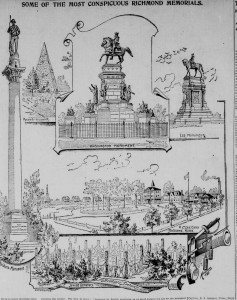
The Richmond Dispatch, 1896.
On the occasion of its 75th anniversary and the national commemoration of the sesquicentennial of the Civil War, VMFA has installed new outdoor signs on its campus that interpret the history of the Confederate Soldiers’ Home, a residential compound for poor veterans that once stood on the site between 1885 and 1941.
Established by R. E. Lee Camp, No. 1, Confederate Veterans, the site once included, among other buildings, nine residential bungalows, a dining hall, hospital, and recreation hall. At peak occupancy, the number of residents exceeded 300. Altogether, a total of nearly 3,000 veterans from 33 states called the camp home. In the mid-20th century, the Commonwealth of Virginia gained ownership of the property and designated the site as the Confederate Memorial Park.
The illustrated signs are located near three surviving buildings from the camp era: the earlier Robinson House (an antebellum farmhouse, renamed Fleming Hall and used by the camp as its administration building); the Home for Needy Confederate Women (now VMFA’s Pauley Center, housing offices and meeting rooms); and the Confederate Memorial Chapel. The museum has also launched a related link on its website, www.vmfa.museum. Under “Visit,” look for “History of the Grounds.”
The interpretive signage is part of three Civil-War themed initiatives undertaken by VMFA. Last spring the museum featured the traveling exhibition Civil War Drawings from the Becker Collection. In summer 2012, the museum will present Bold Cautious True: Walt Whitman and American Art of the Civil War Era, an exhibition that explores 1860s landscapes, genre scenes, and sculpture in relation to the work of Whitman, one of the nation’s leading scribes of the War.
– Dr. Elizabeth O’Leary, Associate Curator of American Art